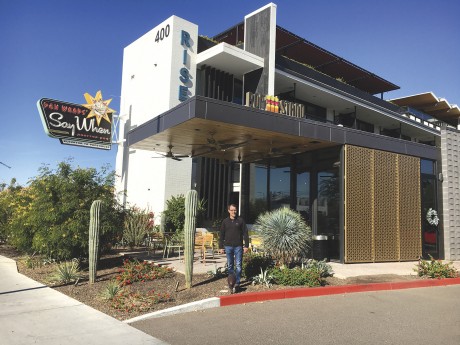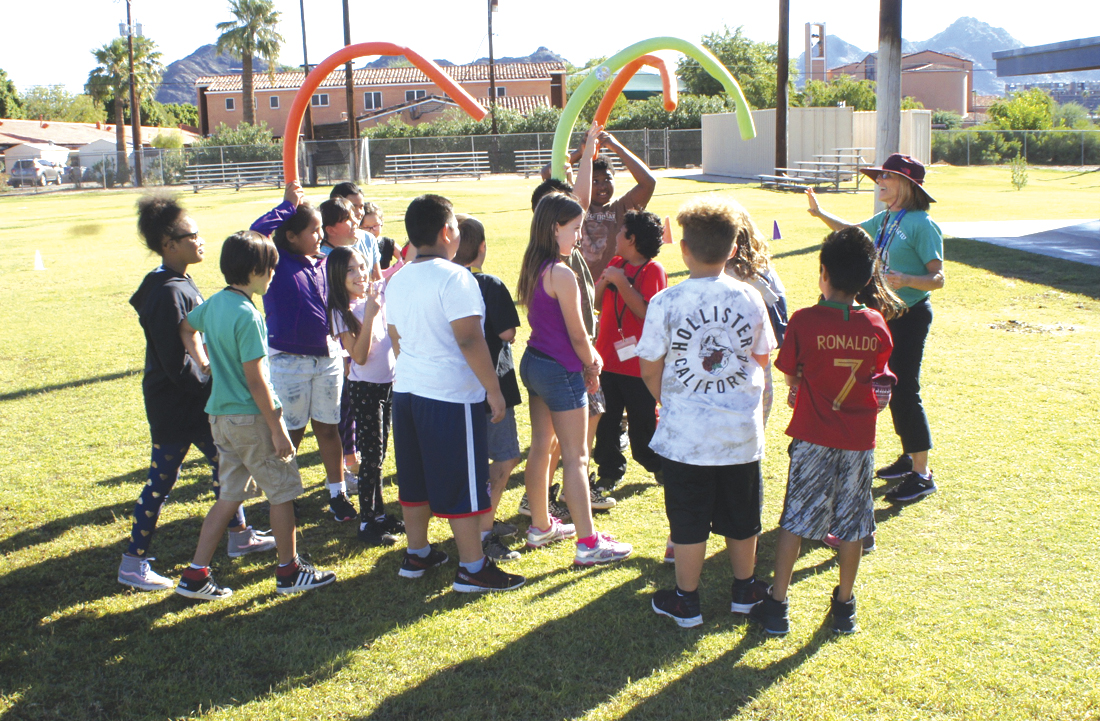Preserving historic neighborhoods, homes and commercial properties is more than a sentimental nod to the past, a new report says.
Preservation also pays dividends through increased property values, improves the environment and helps conserve affordable housing, says “Preservation Phoenix Style: A Study of the Impacts of Historic Preservation in Phoenix,” conducted by consultants PlaceEconomics and the Phoenix Historic Commission. The 66-page report is a comprehensive look at the city’s historic preservation efforts over the past several decades,

The Rise Uptown hotel, which was originally two mid-century office buildings, was transformed by Lorenzo Perez and Venue Projects, which is helping to revitalize the area around 4th Avenue and Camelback Road (photo by Marjorie Rice).
In North Central Phoenix, historic neighborhoods including Windsor Square and Medlock Place, and the resurgence of restaurants, and revamped commercial buildings along Seventh Street, and Central and Seventh avenues, demonstrates the benefits of preservation rather than demolition, said Historic Commission Chair Dan Klocke.
“We have value in our older buildings that should not be overlooked,” he said. “The data shows that when used in a smart way, historic preservation can strengthen our local economy and businesses and be very productive.”
The commission will begin talks with City of Phoenix planning staff about next steps, including increased funding for at-risk buildings and potential changes in zoning codes.
“Neighborhoods that are historically designated are relatively safe from demolition,” Klocke said. “Not completely, but much greater than in non-designated commercial corridors that have buildings that when mixed with old and new can be really fun.”
Upward Projects’ Postino, Windsor, Federal Pizza, Churn and Joy Ride restaurants on Central Avenue “are great examples of using older buildings and adapting them for new uses,” Klocke said.
Another is the Melrose neighborhood, where Melrose Pharmacy owner Teresa Dickinson worked with owners of Figs Home and Garden, Copper Star coffeeshop and Wag N’ Wash pet food and grooming to form a merchants association.
Dickinson bought the Wagon Wheel building, a strip mall, in 2005. “It was basically a hoarder’s paradise, filled with junk,” she said. “We worked really hard on revitalizing the area. It used to be a bunch of vacant buildings, with a lot of crime, and since we formed the Seventh Avenue Merchants Association the neighborhood has really picked up.”
Now her property houses a restaurant, wine shop, lounge and barbershop as well as the pharmacy. And it’s a magnet for residents.
So are Modern Manor furniture store and Valentine restaurant and lounge, a 60-year-old Melrose-area dry cleaner that went out of business and in 2017 took on a new life, offering a pleasant spot for coffee and conversation, dining and shopping.
Copper Star Coffee is a former gas station – the defunct pumps are still out front – now a coffeeshop and a popular hangout.
“The neighborhood is very supportive of our businesses,” Dickenson said “We’re like a small town within a big city.”
Another neighborhood where re-use of old commercial properties is booming is the area around Central and Camelback avenues, between 7th Avenue and 7th Street.
Venue Projects’ Rise Uptown hotel on Camelback and 4th Avenue, and the The Newton next door, are helping to revitalize the area, said Venue co-owner Lorenzo Perez. The company also is a partner in the renovation of the old Beef Eater’s into The Newton, with a mix of retail and dining. Perez, an architect by training, founded Venue Projects with partner Jon Kitchell in 2008, early in the Great Recession.
“We saw properties at reasonable prices that would allow us the opportunity to experiment and innovate with them in a new way. Historic neighborhoods were resurging in the ’90s and 2000s and I remember thinking, ‘Why isn’t commercial following suit?’”
The company has transformed properties in North Central Phoenix and sees potential in areas that have been largely overlooked as adaptive use candidates.
The Rise Uptown hotel originally was two executive office buildings. “We liked its mid-century architecture,” Perez said. “We thought it would be an opportunity to tell Phoenix’s history as a ’50s city; it really came into its own during that era. It’s been fun to give it new life.
“Our goal – our whole business model as a company – was to preserve heritage buildings and creatively redevelop them into unique places that celebrated our Phoenix heritage, and use them as opportunities to tell those old stories and start celebrating our culture.
“But we’re never going to have our history and heritage if we keep erasing it. Let’s show the value of old structures and what we can do with them to generate strong neighborhoods and create economic opportunity for entrepreneurs.”
Sunnyslope could be the next area for that kind of revitalization, Perez said. Where others might see nondescript strip malls and small commercial buildings, Perez sees opportunity.
“There is great building stock there,” he said. “They have a lot of that precious old small-scale commercial that is, in my opinion, irreplaceable. It’s at a price where a lot of small, mom-and-pop businesses can operate, and it would be really hard to do that scale of commercial today with that kind of character, at a cost that’s feasible.”
Not everyone is on-board with the push for preservation – at least when it comes to historic designation for homes outside historic neighborhoods.
Bobby Lieb of HomeSmart Realty, who has been working with buyers and sellers in North Central Phoenix for 30 years, says historic designation can turn off potential buyers, who want freedom to do what they want with their property.
Buyers looking in designated historic neighborhoods such as Encanto and The Willo are ready to live with the restrictions in such areas, he said, but the average person who comes to North Central is turned off if they can’t do what they want – up to and including razing a vintage home on a large lot and subdividing it. He cites horse properties as an example.
“A lot of people don’t like to see these properties taken down,” Lieb says, adding that the properties, often on large lots, often are bought by developers who tear down the buildings and subdivide the land.
Lieb understands his view is not popular with people who want to preserve these vintage properties.
“People who have lived there forever don’t want to see changes,” he said. “But in the real world it’s up to the family, and they want the most money they can get. That has driven prices up. Now instead of seeing two and one-half acres just sitting there with a 100-year-old house, you’ve got five, six new homes that are going for $1.5 million-plus, and that helps everybody.”
Rick Ramella, a realtor with Highland Real Estate for 14 years and a member of the North Central Phoenix Homeowners Association board of directors, says his clients are a mix, with some wanting older homes despite potential restrictions, and others who would not touch anything designated historic because of those restrictions.
“You’ll always find buyers for older homes, places that were built in the ’50s and ’60s,” he said. “People eat that up.”
Ramella estimated 200 to 300 homes in the North Central area likely are designated historic or located in the area’s five historic neighborhoods: Medlock Place, Pierson Place, Windsor Square, Woodlea and Yaple Park.
On the commercial side, Ramella praised groups like Upward Projects and the Melrose Merchants Association for adapting and re-using vintage properties that add character to those neighborhoods. “Some of the best cities I’ve been to have a lot of historic stuff, and that is part of what gives a city its character and in some ways defines what it is.
“I’m really glad they saved those buildings and made something really cool out of them,” he said.
His clients like them, too, Ramella said. “That’s a huge selling point when people can walk or bike to a place like that. It’s why you see it mentioned in half the listings for the Central Corridor: ‘Just up the street from Windsor and Postino and Federal Pizza.’ ”
The 66-page study, “Preservation Phoenix Style: A Study of the Impacts of Historic Preservation in Phoenix,” is available online at phoenix.gov/pddsite/Documents/Preservation.













































